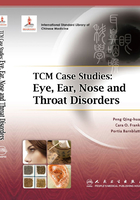
上QQ阅读APP看书,第一时间看更新
CASE STUDY
Female, age 51. Initial Visit: August, 2009
Chief Complaints: Sudden onset of redness, swelling and persistent tearing around the inner canthus of the lef eye for three days. Symptoms became aggravated one day prior to treatment.
History: Sudden onset of the symptoms appeared three days prior to treatment accompanied by dry stools and constipation for a week.
Signs and Symptoms: Pain, redness and swelling around the inner canthus of the lef eye with persistent tearing. There was redness, swelling and the appearance of a hard nodule under the point BL 1 ( jīng míng). The swelling reached to the eyelid, with pain upon palpation. Other symptoms included nodules and pain in the preauricular and submaxillary areas on the lef side, headache, fever, thirst, restlessness, dry and hard stools and reddish, difcult urination. The tongue body was red with a yellow coating. The pulse was rapid and forceful.
Past History: Patient was diagnosed with chronic dacryocystitis in the left eye approximately one year prior to treatment.
Pattern Differentiation
The main characteristics of this patient were: sudden onset of pain, redness and swelling around the inner canthus area three days prior to treatment. The swelling reached to the eyelid. Thirst and restlessness developed afer, followed by dry, hard stools and reddish, difficult urination. A pale red hard nodule appeared under the lef inner canthus with aversion to palpation due to pain, persistent tearing, swollen nodules in the left preauricular and submaxillary areas, headache, fever, thirst and restlessness, dry, hard stools and reddish and difcult urination. The tongue body was red with yellowish coating. The pulse was rapid and forceful.
According to the Five Wheel theory, the inner canthus belongs to the heart and the eyelid belongs to the spleen. In this case, heat in the heart and spleen attacked upwards resulting in pain and causing a reddish hard nodule to appear in the eyelid. Toxic heat congestion blocking the collaterals combined with qi and blood stasis resulting in red, hard and swollen nodules with aversion to palpation. Pathogenic toxins residing in the channel led to pain and nodules in the preauricular and submaxillary areas. The causative factors for the headache, fever and restlessness were heat excess in the yangming channel with internal heart fre disturbance. Heat-injured fuids caused the dry mouth and thirst, while the dry bound stools, red and difcult urination, red tongue body with a yellowish coating and the rapid forceful pulse were all signs of excess fre toxins.
The inner canthus belongs to the heart and the eyelid belongs to the spleen, therefore, the location in this case is in the heart and spleen. It belonged to the paterns of toxic heat in heart and spleen, and was a case of excessive fre.
Diagnosis
WM diagnosis: Acute dacryocystitis
TCM diagnosis: Weeping canthus sore due to excessive toxic heat in heart and spleen
Clinical Treatment
The main patern in this case is excessive heat. The etiology of the root cause is toxic heat in the heart and spleen attacking upwards. According to the principle of treating the root in any condition, the primary treatment is to clear and eliminate the toxic heat in the heart and spleen.
Principles: Clear heat and resolve toxins, resolve stasis and dissipate nodules
Formula: Modified Huáng Lián Jiĕ Dú Tāng (Coptis Toxin-Resolving Decoction) and Wŭ Wèi Xiāo Dú Yĭn (Five Ingredients Toxin-Removing Beverage)
[黄连解毒汤合五味消毒饮加减]

[Formula Analysis]
This formula is composed of Huáng Lián Jiĕ Dú Tāng combined with Wŭ Wèi XiāoDú Yĭn plus tiān huā fĕn, chì sháo and gān căo. Huáng Lián Jiĕ Dú Tāng is a classical formula that treats toxic heat in the three jiao. Wŭ Wèi Xiāo Dú Yĭn clears heat and resolves toxins. It is commonly used to dissipate nodules and treat clove sore. Combining these formulas strengthens the power of clearing and draining toxic fire. Adding tiān huā fĕn clears heat, generates fluids, dissipates swelling and expels pus; chì sháo cools and invigorates blood and dissolve stasis. Gān căo harmonizes the formula.
External Therapy
Eye drops: Apply antibiotic eye drops, several times daily.
Moist warm compress: 2-3 times daily.
Topical application: Consider applying Zĭ Jīn Dìng (Purple Gold Lozenge) or RúYì Jīn Huáng Săn (Agreeable Golden Yellow Powder) as an external compress to clear heat, relieve toxins and dissipate swelling. The patient should be advised that this is for external use only and contact with the eye must be avoided.
Chinese Patent Medicine
Niú Huáng Jiĕ Dú Wán (Bovine Bezoar Toxin-Resolving Pill), oral administration, one pill per dose, three doses daily.
Other Therapies
Antibiotic treatment can be added, based on the patient’s systemic symptoms.
Further Consultation
Five days afer the above treatment, the symptoms of pain, redness, swelling and persistent tearing around the inner canthus of the lef eye was markedly reduced. The areas of redness and swelling below the point BL 1 ( jīng míng) of the inner canthus had become significantly smaller. The symptoms of headache, fever, restlessness, thirst, dry bound stools, red and difcult urination had disappeared. The tongue body was still red with white coating, and the pulse was rapid. This showed that excessive toxic fre in the heart and spleen had been relieved, however, the heat pathogen remained.
Principles: Clear heat and drain fre to disperse stasis and dissipate nodules
Formula: Modifed Dăo Chì Săn (Red-Guiding Powder)
[导赤散加减]

[Formula Analysis]
Shēng dì huáng cools the blood, nourishes the yin and controls heart fre.
Chē qián căo, dàn zhú yè and tōng căo clear heart fire in the upper heart channel and direct heat downward to the small intestine channel.
Tiān huā fĕn clears heat, generates fuids, dissipates swelling and expels pus.
Yì yĭ rén clears heat and expels pus.
Chì sháo cools and invigorates blood, while also dissolving stasis.
Shēng gān căo clears heat, resolves toxin and harmonizes the formula.